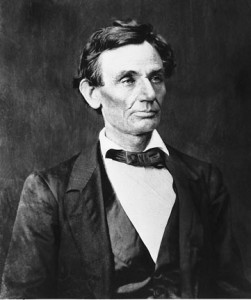 On April 6, 1858, in Bloomington, Illinois, Abraham Lincoln gave his first science lecture on what has become known as “Discoveries and Inventions.” Or maybe he wrote two lectures by that name; the issue is a bit murky.
On April 6, 1858, in Bloomington, Illinois, Abraham Lincoln gave his first science lecture on what has become known as “Discoveries and Inventions.” Or maybe he wrote two lectures by that name; the issue is a bit murky.
The Daily Pantagraph reported that “Mr. Lincoln is an able and original thinker, and in the department of literature fully sustains the reputation he has so justly earned at the bar.” Others, including Lincoln’s law partner William Herndon, were not so charitable, calling the lecture a “dull, lifeless thing.”
In any case, analyzing the Lecture on Discoveries and Inventions is complicated by the fact that only what appear to be partial transcripts of the lecture remain. John Nicolay in a Century Magazine article called “Lincoln’s Literary Experiments,” and later in the Nicolay and Hay Life of Lincoln, reports only the second half of the lecture. Basler’s Collected Works of Abraham Lincoln has both parts of the lecture, but lists them in two separate volumes as if they were two separate lectures. The confusion comes from the two handwritten parts of the lecture left with the only surviving daughter of Mary Lincoln’s uncle, who passed them to Dr. Samuel Melvin after Lincoln’s assassination, who, believing they were separate lectures, kept one part and sold the other part to Charles Gunther, who later sold it to renowned Lincoln collector Oliver Barrett. In the 1990s, historian Wayne Temple demonstrated clearly that the two parts were indeed from the same lecture. A prominent Bloomington, Illinois newspaper, the site of his most well-attended version of the lecture, carried a significant accounting that includes reference to both sections of the lecture, as well as two subjects—laughter and music—that are not in either section. The lecture most likely included another written piece in the middle, now lost, or Lincoln improvised as he spoke. The two pieces also include some overlap and seeming repetition, for example mentioning Adam’s fig-leaf and steam power in both, which suggests that both pieces are early drafts that Lincoln revised and consolidated into a final lecture.
More recently, Mary and Robert Lincoln historian Jason Emerson discovered letters between Robert and John Nicolay revealing that the two pieces, perhaps additional missing segments, and maybe some revisions, were contained in “a mss [manuscript] book, thin, in black cover, evidently got for the purpose of copying the Lecture into it, as was done in my father in his own hand.” Robert concluded that book was “evidently the one used in delivery.” Unfortunately, Robert lost the book and it has never been found.
Whatever the final length, Lincoln gave the lecture on as many as six different occasions in central Illinois between April 1858 and April 1860. The first was in Bloomington on April 6, 1858. Ten months later, he repeated the lecture in Jacksonville and again in Springfield on February 21, 1859. After giving it in Decatur in January 1860, his planned repeat in Bloomington in April was cancelled as it was about to begin due to poor turnout. His return engagement in Springfield two months after rising to national prominence with his Cooper Union speech, however, was given before a “large and intelligent audience.” Many more requests for Lincoln to present the lecture were made by prominent community leaders across the state, but Lincoln limited himself to places and times that coincided with legal and political business so as not to inconvenience himself.
[Adapted from my forthcoming book]
David J. Kent is the author of Lincoln: The Man Who Saved America. His newest Lincoln book is scheduled for release in February 2022. His previous books include Tesla: The Wizard of Electricity and Edison: The Inventor of the Modern World and two specialty e-books: Nikola Tesla: Renewable Energy Ahead of Its Time and Abraham Lincoln and Nikola Tesla: Connected by Fate.
Follow me for updates on my Facebook author page and Goodreads.










